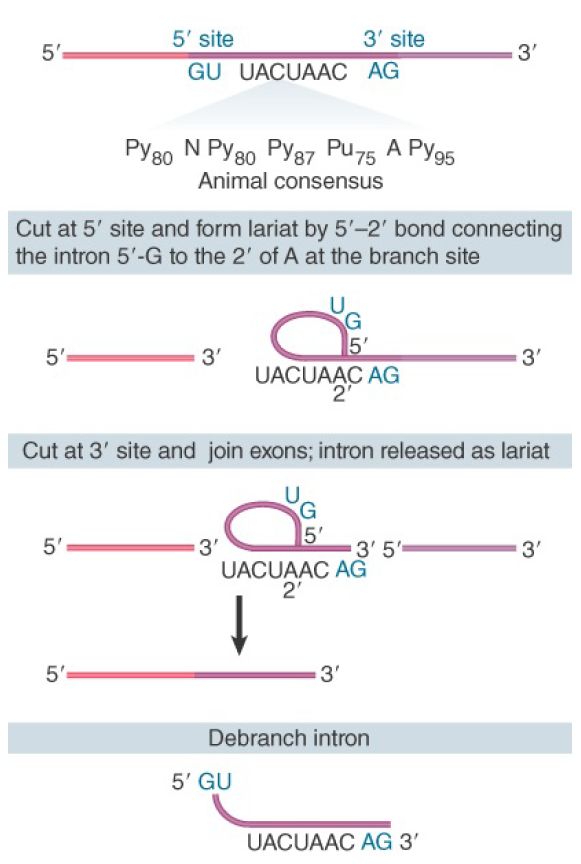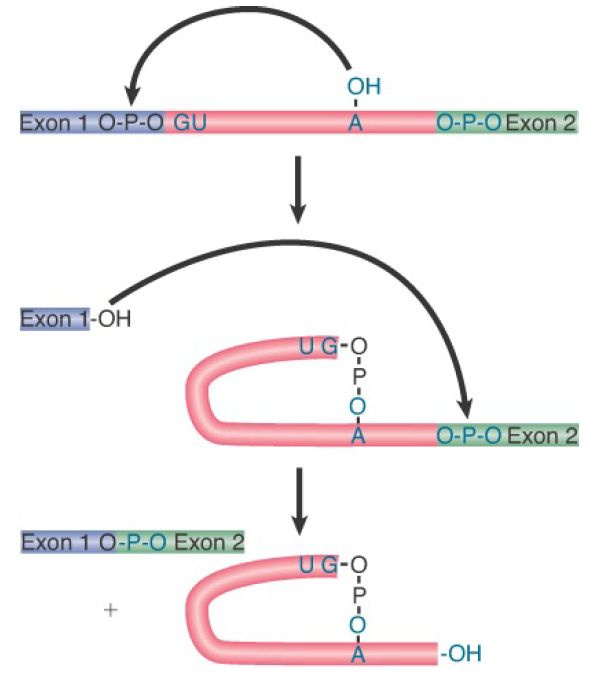


 النبات
النبات
 الحيوان
الحيوان
 الأحياء المجهرية
الأحياء المجهرية
 علم الأمراض
علم الأمراض
 التقانة الإحيائية
التقانة الإحيائية
 التقنية الحيوية المكروبية
التقنية الحيوية المكروبية
 التقنية الحياتية النانوية
التقنية الحياتية النانوية
 علم الأجنة
علم الأجنة
 الأحياء الجزيئي
الأحياء الجزيئي
 علم وظائف الأعضاء
علم وظائف الأعضاء
 الغدد
الغدد
 المضادات الحيوية
المضادات الحيوية|
Read More
Date: 15-5-2016
Date: 2025-02-27
Date: 9-5-2021
|
Pre-mRNA Splicing Proceeds Through a Lariat
KEY CONCEPTS
- Splicing requires the 5′ and 3′ splice sites and a branch site just upstream of the 3′ splice site.
- The branch sequence is conserved in yeast but less well conserved in multicellular eukaryotes.
- A lariat is formed when the intron is cleaved at the 5′ splice site and the 5′ end is joined to a 2′ position at an A at the branch site in the intron.
- The intron is released as a lariat when it is cleaved at the 3′ splice site, and the left and right exons are then ligated together.
The mechanism of splicing has been characterized in vitro using cell-free systems in which introns can be removed from RNAprecursors. Nucl ear extracts can splice purified RNA precursors; this shows that the action of splicing does not have to be linked to the process of transcription. Splicing can occur in RNAs that are neither capped nor polyadenylated even though these events normally occur in the cell in a coordinated manner, and the efficiency of splicing may be influenced by transcription and other processing events .
The stages of splicing in vitro are illustrated in the pathway of FIGURE 2. The reaction is discussed in terms of the individual RNA types that can be identified, but remember that in vivo the types containing exons are not released as free molecules but remain held together by the splicing apparatus.

FIGURE 1 Splicing occurs in two stages. First the 5′ exon is cleaved off, and then it is joined to the 3′ exon.
FIGURE 2. shows that the first step of the splicing reaction is a nucleophilic attack by the 2′–OH on the 5′ splice site. The left exon takes the form of a linear molecule. The right intron–exon molecule forms a branched structure called the lariat, in which the 5′ terminus generated at the end of the intron simultaneously transesterificates to become linked by a 2′–5′ bond to a base within the intron. The target base is an A in a sequence called the branch site.

FIGURE 2. Nuclear splicing occurs by two transesterification reactions, in which an –OH group attacks a phosphodiester bond.
In the second step, the free 3′–OH of the exon that was released by the first reaction now attacks the bond at the 3′ splice site. Note that the number of phosphodiester bonds is conserved. There were originally two 5′–3′ bonds at the exon–intron splice sites; one has been replaced by the 5′–3′ bond between the exons and the other has been replaced by the 2′–5′ bond that forms the lariat. The lariat is then “debranched” to give a linear excised intron that is rapidly degraded.
The sequences needed for splicing are the short consensus sequences at the 5′ and 3′ splice sites and at the branch site. Together with the knowledge that most of the sequence of an intron
can be deleted without impeding splicing, this indicates that there is no demand for specific conformation in the intron (or exon).
The branch site plays an important role in identifying the 3′ splice site. The branch site in yeast is highly conserved and has the consensus sequence UACUAAC. The branch site in multicellular eukaryotes is not well conserved but has a preference for purines or pyrimidines at each position and retains the target A nucleotide. The branch site is located 18 to 40 nucleotides upstream of the 3′ splice site. Mutations or deletions of the branch site in yeast prevent splicing. In multicellular eukaryotes, the relaxed constraints in its sequence result in the ability to use related sequences (called cryptic sites) when the authentic branch is deleted or mutated.
Proximity to the 3′ splice site appears to be important because the cryptic site is always close to the authentic site. A cryptic site is used only when the branch site has been inactivated. When a
cryptic branch sequence is used in this manner, splicing otherwise appears to be normal, and the exons give the same products as the use of the authentic branch site does. The role of the branch site is therefore to identify the nearest 3′ splice site as the target for connection to the 5′ splice site. This can be explained by the fact that an interaction occurs between protein complexes that bind to these two sites.



|
|
|
|
دخلت غرفة فنسيت ماذا تريد من داخلها.. خبير يفسر الحالة
|
|
|
|
|
|
|
ثورة طبية.. ابتكار أصغر جهاز لتنظيم ضربات القلب في العالم
|
|
|
|
|
|
|
العتبة العباسية المقدسة تستعد لإطلاق الحفل المركزي لتخرج طلبة الجامعات العراقية
|
|
|